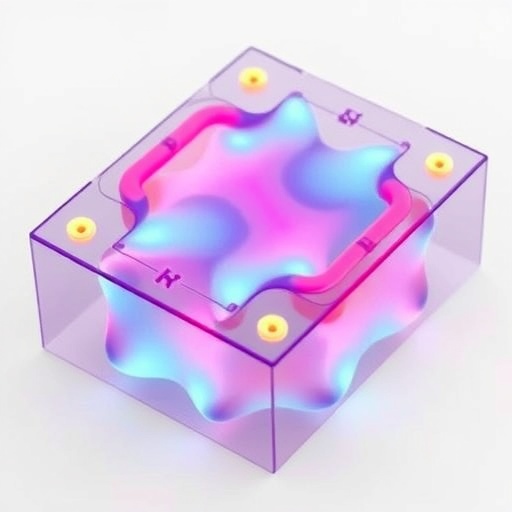In the relentless pursuit of next-generation wearable electronics, the marriage of flexibility and efficiency in energy harvesting devices has long represented a formidable challenge. A recent breakthrough led by Huang, Chen, Jiang, and colleagues, published in the prestigious journal npj Flexible Electronics, promises to upend prevailing limitations through an innovative approach: microfluidic-enabled three-dimensional (3D) stretchable thermoelectrics. This pioneering work ushers in a new era of thermoelectric materials capable of conforming seamlessly to irregular surfaces and enduring significant mechanical deformation, all while maintaining—or even enhancing—their energy conversion efficiency.
Thermoelectric devices, which convert temperature gradients directly into electrical energy, have attracted widespread interest for their potential applications in powering wearable sensors, medical implants, and soft robotics. Traditionally, the brittleness and planar configuration of thermoelectric materials have imposed strict constraints on their integration into flexible platforms. Attempts to embed these materials into stretchable substrates typically result in compromised performance due to mechanical fractures and degraded conductivity. The team’s novel microfluidic strategy deftly circumvents these obstacles by engineering intricate 3D architectures that reconcile flexibility, stretchability, and thermoelectric functionality in a single, cohesive system.
At the heart of this breakthrough lies the ingenious exploitation of microfluidic channels—minuscule conduits capable of precisely directing and confining liquid phases within elastomeric matrices. The researchers utilized these microfluidic pathways to deposit thermoelectric materials in predefined, three-dimensional configurations that inherently accommodate volumetric strain. By embedding the thermoelectric elements within elastomers such as polydimethylsiloxane (PDMS), the resultant composites exhibit exceptional mechanical resilience, supporting stretching, twisting, and bending while preserving their core electrical and thermal transport properties.
.adsslot_6kaFtcY753{ width:728px !important; height:90px !important; }
@media (max-width:1199px) { .adsslot_6kaFtcY753{ width:468px !important; height:60px !important; } }
@media (max-width:767px) { .adsslot_6kaFtcY753{ width:320px !important; height:50px !important; } }
ADVERTISEMENT
Thermoelectric performance, quantified by metrics such as the Seebeck coefficient, electrical conductivity, and thermal conductivity, traditionally degrades when materials are subjected to mechanical rigor. Remarkably, the microfluidic-enabled 3D architecture not only preserves but in some configurations enhances these properties due to optimized heat flow management and intrinsic strain adaptation. The coupling of microfluidic design with material science insights leads to unconventional geometries that exploit the interplay of thermal gradients and elastic deformation to maintain high energy conversion efficiency under stretch.
Beyond mechanical resilience, thermal management emerges as a critical advantage afforded by the microfluidic channels themselves. The liquid media used within these pathways can facilitate heat redistribution, effectively modulating thermal paths and mitigating hotspots that ordinarily induce performance bottlenecks. This active thermal control presents a unique lever for optimizing thermoelectric efficiency in wearable settings, where ambient temperature fluctuations and human motion regularly distort device operating conditions.
In exploring material choices, the research probes beyond conventional bismuth telluride and other brittle compounds prevalent in thermoelectrics. Innovative formulations featuring conductive polymers, nanocomposites, and hybrid organic-inorganic blends are investigated for compatibility with the microfluidic patterning processes. These materials offer tunable mechanical compliance alongside favorable thermoelectric parameters, synergizing with the 3D architecture to elevate overall device performance.
Underlying the achievements is a multidisciplinary confluence of microfluidics, polymer chemistry, thermodynamics, and electronic engineering. The design principles elucidated in this study underscore the profound potential unlocked when traditionally disparate scientific domains intersect. By tailoring microscale geometries and exploiting fluid dynamics within elastomeric hosts, the researchers chart a pathway toward stretchable electronics that dynamically integrate sensing, actuation, and energy harvesting functions.
From an ecological standpoint, enhancing thermoelectric harvesting from low-grade thermal sources, such as body heat lost during metabolism, touches upon sustainability goals. Wearable devices enhanced by this technology could reduce dependence on bulky batteries and frequent charging cycles, promoting longer-lasting, maintenance-free electronics that mesh effortlessly with daily life. The non-invasive energy scavenge approach also aligns with emerging trends in personalized healthcare and real-time monitoring.
Technically, the research addresses several key challenges inherent to stretchable electronics: achieving reliable electrical contacts amidst strain, balancing mechanical deformation with thermal conductivity, and circumventing delamination or structural failure from cyclic use. Through clever microfluidic channel designs that permit fluidic encapsulation and mechanical decoupling, these issues are elegantly mitigated. The seamless interoperability between rigid thermoelectric semiconductors and soft elastomers is a hallmark outcome of their methodology.
Of particular note is the dynamic modulation capability observed when varying microfluidic channel parameters such as diameter, length, and filling medium. Devices exhibited tunable mechanical properties and thermal responses by virtue of fluid movement and channel deformation under stress conditions, opening avenues for responsive systems that adapt performance in real-time. Such adaptability is a common motif in biological systems and marks a transformative step toward biomimetic wearable electronics.
The research team concludes by envisioning a new generation of flexible thermoelectrics that do not merely survive mechanical perturbations but thrive because of them—leveraging strain-induced modifications to optimize functional output. This paradigm shift challenges conventional design dogmas and inspires future innovations where comfort, form factor, and sustainability coalesce without compromise.
As this research gains traction, interest is expected to surge in portable, self-powered electronic devices that users can wear as comfortably as clothing yet whose energy sourcing is as reliable as traditional rigid batteries. The melding of microfluidics with thermoelectric science presents a fertile terrain for intellectual exploration and commercial exploitation, foretelling a vibrant revolution in how we think about and deploy flexible energy systems.
In summary, the seminal work by Huang et al. sets a robust foundation for realizing stretchable thermoelectric devices that marry advanced fabrication technologies with cutting-edge materials science. Its implications resound across fields ranging from soft robotics to personal healthcare monitoring, signaling a compelling stride toward truly flexible, multifunctional electronics optimized for the dynamic human environment.
Subject of Research: Development of microfluidic-enabled three-dimensional stretchable thermoelectric devices for flexible and wearable electronics.
Article Title: Microfluidic-enabled three-dimensional stretchable thermoelectrics.
Article References:
Huang, Z., Chen, T., Jiang, Y. et al. Microfluidic-enabled three-dimensional stretchable thermoelectrics. npj Flex Electron 9, 52 (2025). https://doi.org/10.1038/s41528-025-00429-0
Image Credits: AI Generated
Tags: 3D stretchable thermoelectricsadvanced materials engineeringbreakthroughs in flexible electronicsefficient energy conversion techniquesenergy harvesting in wearable devicesflexible thermoelectric materialsinnovative thermoelectric applicationsmechanical deformation in electronicsmicrofluidic technology in electronicsnext-generation wearable sensorssoft robotics power solutionsthermoelectric device integration challenges





